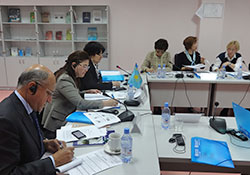Experts gather to debate child injury prevention

WHO
Astana, Kazakhstan, 30 October 2014
Injury is the leading cause of childhood death in Kazakhstan. Responding to concern about the high rate of childhood injury, 28 stakeholders debated possible ways to reduce this burden at a meeting called by WHO and the Ministry of Health and Social Development on 30 October 2014 in Astana, Kazakhstan.
The meeting was opened by Dr Megripa Embergenova, Deputy Director of Department of Health Services, Dr Melita Vujnovic, WHO Head of Country Office and Dr Tamara Voschenkova, Chair of the Republican Mother and Child Health Centre. Dr Embergenova stressed the critical timing of the workshop for inclusion of child injury prevention as a priority in the new health-for-all policy being developed in Kazakhstan for 2016–2020.
Dr Dinesh Sethi, programme manager at Violence and Injury Prevention, WHO/Europe, presented the status of childhood injuries in the European Region and emphasized the high burden from road crashes, drowning and poisonings in Kazakhstan.
The whole-of-society approach promoted by the European health policy, Health 2020, is essential for child injury prevention. Data from Kazakhstan presented by Dr Bolat Nagymanov (Chief Child Traumatologist) and Dr Talgat Nugumanov (Director, Republican Centre for e-Health) showed the large burden of hospitalization from child injuries. A third of all injury admissions were due to head and neck trauma and two thirds of injuries requiring hospitalization occurred in the home. Almost half the children with severe injuries were disabled. There was wide-ranging discussion on how to move the debate forward on childhood injury prevention in Kazakhstan.
The group recommended establishment of a multisectoral task force, which would develop an action plan to achieve a 20% reduction in child mortality by 2020. The group suggested 3 ways to achieve this target:
- building capacity for injury prevention among health and other professionals using TEACH-VIP;
- promoting the use of evidence-based measures as delineated in the world and European reports on child injury prevention; and
- making available 4-digit external cause injury surveillance data at a regional level to promote and monitor local action, and to incorporate such a plan in the new Health Plan for Kazakhstan 2016–2020.



